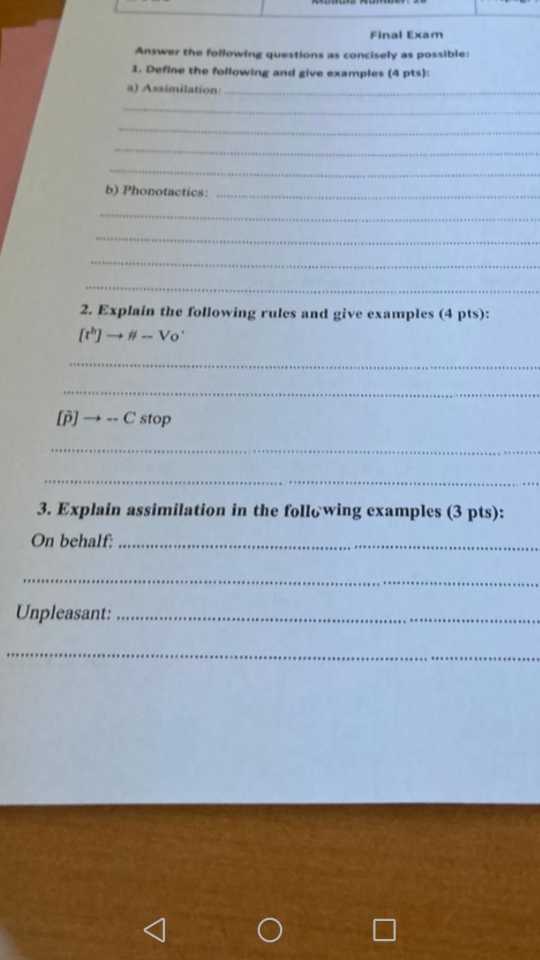Final Exam Questions: 1. Define the following and give examples: a) Assimilation b) Phonotactics 2. Explain the following rules and give examples: [tʰ] → # - Vo [p] → -- C stop 3.... Final Exam Questions: 1. Define the following and give examples: a) Assimilation b) Phonotactics 2. Explain the following rules and give examples: [tʰ] → # - Vo [p] → -- C stop 3. Explain assimilation in the following examples: On behalf: Unpleasant:

Understand the Problem
The user has uploaded an image of a linguistics exam paper. The questions require definitions and explanations of linguistic concepts such as assimilation, phonotactics, and phonological rules. The student needs to provide examples for each.
Answer
1a) Assimilation: Sounds become similar (e.g., 'hambag' for 'handbag'). 1b) Phonotactics: Sound sequence rules (e.g., 'ng' can't start words in English). 2a) [tʰ] → # - Vo: Voiceless stop aspirated at word start (e.g., 'top'). 2b) [p] → -- C stop: Voiceless stop unreleased before another stop (e.g., 'apt'). 3a) On behalf: /n/ in 'on' becomes /m/. 3b) Unpleasant: /n/ in 'un' becomes /m/.
a) Assimilation: A sound change where phonemes become similar to nearby sounds. Example: 'handbag' pronounced as 'hambag'. b) Phonotactics: Rules governing possible sound sequences in a language. Example: In English, 'ng' can't start a word. 2. [tʰ] → # - Vo: A voiceless stop becomes aspirated at the beginning of a word before a vowel. Example: The /t/ in 'top' is aspirated. [p] → -- C stop: A voiceless stop is unreleased before another stop. Example: The /p/ in 'apt' is unreleased. 3. On behalf: /n/ in 'on' becomes /m/ to match the /b/ in 'behalf'. Unpleasant: /n/ in 'un' becomes /m/ to match the /p/ in 'pleasant'.
Answer for screen readers
a) Assimilation: A sound change where phonemes become similar to nearby sounds. Example: 'handbag' pronounced as 'hambag'. b) Phonotactics: Rules governing possible sound sequences in a language. Example: In English, 'ng' can't start a word. 2. [tʰ] → # - Vo: A voiceless stop becomes aspirated at the beginning of a word before a vowel. Example: The /t/ in 'top' is aspirated. [p] → -- C stop: A voiceless stop is unreleased before another stop. Example: The /p/ in 'apt' is unreleased. 3. On behalf: /n/ in 'on' becomes /m/ to match the /b/ in 'behalf'. Unpleasant: /n/ in 'un' becomes /m/ to match the /p/ in 'pleasant'.
More Information
Assimilation simplifies pronunciation by making sounds more alike, while phonotactics define a language's sound structure. The other rules describe predictable variations in pronunciation based on phonetic environment.
Tips
A common mistake is confusing assimilation with other phonological processes like deletion or insertion. Focus on the sound becoming similar, not disappearing or adding sounds.
Sources
- Assimilation (phonology) - Wikipedia - en.wikipedia.org
- Phonetic Assimilation: Types and Examples | Vaia - vaia.com
AI-generated content may contain errors. Please verify critical information